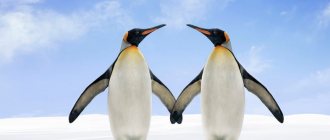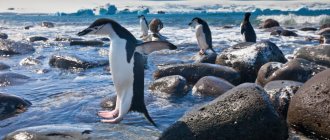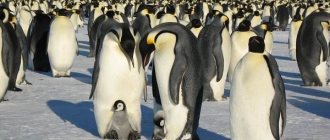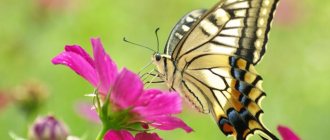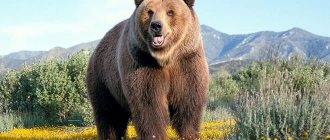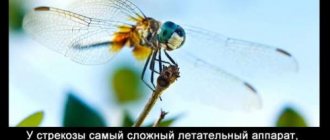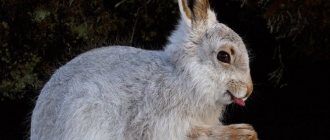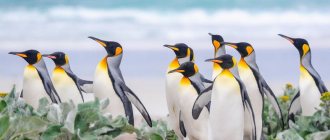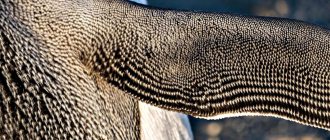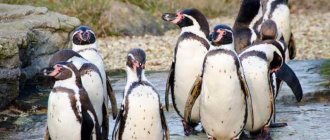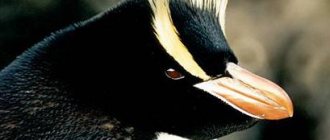This representative of the animal kingdom is part of the penguin family and the spectacled penguin genus. The spectacled penguin (in Latin Spheniscus demersus) has several other names. It is called the African penguin because of its only habitat, the donkey penguin for its sound production, and it is also called the black-footed penguin.
It is interesting that within its genus, it is the largest representative. Moreover, if you put an emperor penguin next to him, ours will seem like just a baby.
Like other penguins, its body structure does not provide for the possibility of flight, but at the same time it is an excellent diver.
In addition to our hero, the genus of spectacled penguins includes: the Galapagos penguin, the Humboldtian penguin and the Magellanic penguin.
This species of penguin is the only one of its family that has chosen a continent such as Africa as its habitat.
No subspecies of the donkey penguin have been identified.
Appearance of a spectacled penguin
The spectacled penguin is the largest representative of the genus. However, relative to other penguins, such as emperor penguins, they can be called babies. Their average weight ranges from 3–5 kg, and their height is 60–70 cm. Like all penguins, they have a dark dorsal and white ventral part of the body. The edges of the latter are bordered by a black horseshoe-shaped stripe, which ends at the base of the neck. On both sides of the head around the eyes there are two oblong spots - the so-called glasses. This feature was the reason for the name of the species.
Male spectacled penguins are slightly larger than females and have thicker beaks. The differences are only visible when both birds are close together. The fused tarsus bones allow these penguins to hold their bodies upright, which is common to all penguins. True, the gait turns out to be quite funny and awkward. The flattened bones of the forelimbs, which turn into flippers, allow penguins to swim and dive well, so they feel much more confident in the water than on land. Unlike other flightless birds such as ostriches and kiwis, penguins have a sternum called the keel. Attached to it are highly developed (even more developed than those of flying birds) pectoral muscles, which provide acceleration when swimming underwater.
Mating season
Animals that are clumsy on land dance beautifully during the mating season. The male raises and lowers his head to show the female his sexual maturity.
The female, paying attention to the male, approaches him, and they begin to dance together. In the process they touch with their beaks, as if kissing. After the dance they put their heads on each other's necks. Mating lasts no more than 10 seconds, and then the process with dancing is repeated.
Lifestyle and nutrition of the spectacled penguin
Spectacled penguins spend most of the year at sea, but at the beginning of the breeding season they swim to the islands or parts of the coast of South Africa. However, during migrations they do not swim far from the shore, so they are classified as sedentary species. Like all penguins, they feel light and free in the water. They can reach speeds of up to 20 km/h, dive to depths of up to 100 m, and hold their breath for 2-3 minutes. During the hunt they can swim 70-120 km. Special organs on the head (pink “eyebrows” above the eyes) help these penguins maintain the required body temperature. The higher the bird's body temperature, the more blood is directed to these organs. And thanks to their thin skin, the blood in them is quickly cooled by the surrounding air. During molting, penguins do not dive into water and lose the opportunity to feed. They spend about 20 days on land without feeding. Spectacled penguins have many enemies, both in the water and on the shore. The main enemy, of course, is humans, and in both penguin habitats (bird catching, egg collection, environmental pollution, etc.). In the water, penguins are hunted by sharks and, less commonly, fur seals. With the latter, spectacled penguins also compete on land for rookery sites and nesting colonies, and in water for food. Large seagulls and, in some places, feral cats pose a danger to chicks and eggs on land.
Spectacled penguins feed on small schooling fish (fry of herring, anchovies, sardines); They eat about 500 g of fish per day. Human overfishing off the coast of Africa is one of the reasons for the decline in the number of this penguin species.
The voice of the spectacled penguin is loud, sharp, similar to the cry of a donkey, for which it is sometimes called the donkey penguin.
Relationships between African penguins and people
It is widely believed that African penguins were one of the first penguin species to come into contact with humans due to the fact that they are found on the temperate coast of South Africa rather than in the heart of Antarctica. However, this apparently did not work in the bird's favor, as their eggs were stolen for food (slowing the rate of reproduction) and the guano used to build the nest was collected for fertilizer. Today, the African penguin faces other threats, including competition for food from commercial fishing and oil pollution in its waters. Tourists can only access a small handful of nesting sites, but the penguins' nervous nature means these sites must be strictly controlled.
Reproduction of spectacled penguins
Spectacled penguins are monogamous birds that mate for a long time. Sexual maturity of individuals occurs upon reaching 4-5 years. The breeding season of spectacled penguins directly depends on climatic conditions; in the southern part of the continent, the peak breeding season for birds occurs in the spring, in Namibia - from November to December. The number of eggs that the female lays is no more than 2. The incubation process is carried out by both representatives of the pair, the duration of the incubation period is about 40 days.
The first outfit of hatched penguin chicks is light gray fluff. At first, the offspring that are born are with their parents. After one month, the young animals are united in the so-called “nursery”. Young penguins receive their first adult plumage at the age of 2 to 4 months; as a rule, the beginning of the first moult directly depends on the habitat and food of the birds. Having received their adult attire, the young offspring go to the sea. In their natural habitat, spectacled penguins live up to 10-12 years.
Habitat
The spectacled penguin lives in southern Africa. Surprisingly, this type of penguin prefers a subtropical climate. Its habitats are located on the coasts of the Republic of South Africa, Namibia and Angola, as well as the islands adjacent to them. Thanks to the cold current and food supply of the Bay of Bengal, which washes these territories, penguins feel good here. It is also found in the Democratic Republic of the Congo.
About twenty-odd existing colonies live in these territories. But there are birds, not yet burdened with thoughts of procreation, which swam to the coasts of Mozambique and Gabon.
They prefer to nest on islands; the mainland is most often avoided.
Population status and conservation of the spectacled penguin
The number of spectacled penguins sharply decreased at the beginning of the twentieth century due to human development of nesting habitats, oil pollution of coastal waters and a number of other reasons also related to human activities. So, if by the beginning of the 19th century the number of this species was estimated at 4 million individuals, then by the end of the 20th century only 10% remained. Thus, the number of African penguins has fallen tens of times and now, according to various estimates, ranges from 50,000 to 170,000 individuals. Currently, this penguin is listed in the Red Book of South Africa and the International Red Book in the group of endangered species - IUCN (EN).
New in blogs
There is one wonderful beach in South Africa called Boulders Beach. It is located on the coast of Simon's Town, approximately halfway from Cape Town to the Cape of Good Hope. Here, look at the photo from above: it can be seen in the lower left part.
Why is it so interesting and good that tourists heading to the Cape of Good Hope often stop by here along the way?
Maybe huge boulders, after which the beach is named? Or maybe... wait... what are those dark dots there, on the strip of sand between the water and the boulders?
Oooh, those are penguins! This is what makes this beach so special: it is home to a fairly large colony of African penguins, the Boulders Penguin Colony!
These cute birds guide you along the path to the beach. They have been living here for a long time, so they roam around quite freely and are not afraid of you. They are the masters here, and the people are guests, so behave politely and well-mannered.
At the entrance in front of this short path to the beach there is a booth where they will sell you a ticket to visit it. I don't remember exactly how much it costs, but it's not too expensive. Don't throw away your ticket, you'll need it later.
On the beach, in addition to a simple walk on the sand between the boulders, you can swim in the summer, and penguins will keep you company - of course, if they want.
However, you will almost certainly have to get your feet wet: if you want to go a little further after the penguins, then, depending on the height of the water, you will need to walk either on wet sand or on one filled with water, and also, if desired, climb on rocks.
But as a reward, you will get the opportunity to watch these simultaneously cute and brutal, serious birds in all sorts of situations, from all sides (but you don’t need to bother them too much, chase them and scare them).
You can film someone’s leisurely, lonely walk along the shore...
...or a group of comrades with varying degrees of preoccupation with their appearance...
...sneak up almost close to a penguin basking on the rocks...
...and, of course, alarm him. They are not tame, but quite wild birds, and although they feel quite calm here, they do not let you get close to them, warily showing curiosity in response or generally perceiving annoying visitors with aggression.
Therefore, it is highly not recommended to reach out to them and try to touch them: they will most likely bite very painfully, since they have very powerful and sharp beaks.
African penguins are an endangered species and are listed as endangered, largely due to uncontrolled human collecting of their eggs in the early 20th century, up to several hundred thousand eggs per year, and within just one century of one and a half million no more than 10% of the population remains.
This colony on Boulders Beach began in the early 1980s when one or two pairs of penguins first settled in. Now, according to various sources, from 2 to 3 thousand birds live there, which have shown amazing affection for this place: once, after an oil spill in the vicinity, people transported all the birds to another place with similar conditions, but every single penguin returned to this beach again .
Some people only need an hour to visit this wonderful place, but we wandered here for at least three to four hours, and we didn’t even swim with them (this is best done in the summer, December-February). Still, penguins are a curiosity for me, especially those that live not in ice and snow, but in quite a warm climate.
By the way, the pink spots around the eyes are glands with the help of which penguins quickly cool themselves through the thin skin in these places, thanks to which they are not afraid of warm weather conditions on land.
We took the issue of visiting penguins seriously: we checked into Simon's Town in the evening, looked at the beach from afar and managed to walk along the free, but very nice Willis Walk trail, which goes among the bushes growing along the beach, and already there we saw the first penguins, mostly nesting among the bushes.
They usually make nests in holes dug in the sand or in the ground. Overall, it was a surprise for me to see these birds among the trees and bushes 
And the very next day, from very early morning, we went for a full walk along the beach. It was very interesting and absolutely everyone liked it. In addition to Boulders Beach itself, you can also visit Foxy Beach by following the Willis Walk to the end. Yes, if you happen to be traveling with dogs, they are not allowed on the beach, and dogs must be on a leash on the Willis Walk.
At the entrance to Foxy Beach, you will need the same ticket purchased for Boulders Beach - you can use it to go to both places. This beach is interesting because there are equipped observation decks right next to the concentration of the penguin colony, where you cannot go along Boulders Beach (and it is prohibited to intrude directly into the penguin habitat).
Here is the main land area of the colony, many penguins hatching eggs, as well as the chicks themselves.
I'll show more photos of the chicks later (I think too many penguins at once can get boring? :)), but I can say right now that it's worth visiting both places - it will be a different experience.
I liked Boulders Beach itself more for the opportunity to be more freely close to the penguins, and not just look at them from afar from behind the fence from the viewing platforms. However, on this beach you will only be able to see adult penguins (in some numbers, not in large numbers) without any babies.
Genus emperor penguins
This genus was the first to separate from the family root, and is therefore called basal. There are only 2 types. One is nominative - imperial, the other, also with a monarchical name - king penguins. These types of penguins in the photo are proud and majestic.
In birds belonging to this genus, the paws play a special role. They serve not only as supports for holding the body in an upright position. At the crucial moment of incubating the egg and protecting the fledgling baby from the cold, they act as a kind of nest.
Penguin feet are not protected from the cold by feathers. The closely intertwined venous and arterial vessels help them avoid freezing. Warmer venous blood gives its temperature to arterial blood. There is a constant process of self-heating. Not only are the paws preserved, the makeshift nest is warmed.
